107 books about New Mexico and 9
start with M
107 books about New Mexico and 9
107 books about New Mexico
9 start with M start with M
9 start with M start with M

Mariana Mesa
Seven Prehistoric Settlements in West-Central New Mexico
Charles R. McGimsey III
Harvard University Press, 1980
A detailed report on the excavations of, and a comprehensive account and analysis of artifacts and materials from, seven settlements that varied in size from units of one or two families to small communities of several dozen individual houses.
[more]
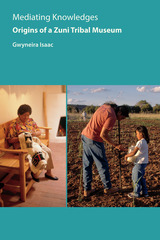
Mediating Knowledges
Origins of a Zuni Tribal Museum
Gwyneira Isaac
University of Arizona Press, 2007
This book tells the story of the search by the Zuni people for a culturally relevant public institution to help them maintain their heritage for future generations. Using a theoretical perspective grounded in knowledge systems, it examines how Zunis developed the A:shiwi A:wan Museum and Heritage Center to mediate between Zuni and Anglo-American values of history and culture. By using in-depth interviews, previously inaccessible archival records, and extensive ethnographic observations, Gwyneira Isaac provides firsthand accounts of the Zunis and non-Zunis involved in the development of the museum.
These personal narratives provide insight into the diversity of perspectives found within the community, as well as tracing the ongoing negotiation of the relationship between Zuni and Anglo-American cultures. In particular, Isaac examines how Zunis, who transmit knowledge about their history through oral tradition and initiation into religious societies, must navigate the challenge of utilizing Anglo-American museum practices, which privilege technology that aids the circulation of knowledge beyond its original narrators.
This book provides a much-needed contemporary ethnography of a Pueblo community recognized for its restrictive approach to outside observers. The complex interactions between Zunis and anthropologists explored here, however, reveal not only Puebloan but also Anglo-American attitudes toward secrecy and the control of knowledge.
These personal narratives provide insight into the diversity of perspectives found within the community, as well as tracing the ongoing negotiation of the relationship between Zuni and Anglo-American cultures. In particular, Isaac examines how Zunis, who transmit knowledge about their history through oral tradition and initiation into religious societies, must navigate the challenge of utilizing Anglo-American museum practices, which privilege technology that aids the circulation of knowledge beyond its original narrators.
This book provides a much-needed contemporary ethnography of a Pueblo community recognized for its restrictive approach to outside observers. The complex interactions between Zunis and anthropologists explored here, however, reveal not only Puebloan but also Anglo-American attitudes toward secrecy and the control of knowledge.
[more]

Men on the Moon
Collected Short Stories
Simon J. Ortiz
University of Arizona Press, 1999
When Faustin, the old Acoma, is given his first television set, he considers it a technical wonder, a box full of mystery. What he sees on its screen that first day, however, is even more startling than the television itself: men have landed on the moon. Can this be real? For Simon Ortiz, Faustin's reaction proves that tales of ordinary occurrences can truly touch the heart. "For me," he observes, "there's never been a conscious moment without story."
Best known for his poetry, Ortiz also has authored 26 short stories that have won the hearts of readers through the years. Men on the Moon brings these stories together—stories filled with memorable characters, written with love by a keen observer and interpreter of his people's community and culture. True to Native American tradition, these tales possess the immediacy—and intimacy—of stories conveyed orally. They are drawn from Ortiz's Acoma Pueblo experience but focus on situations common to Native people, whether living on the land or in cities, and on the issues that affect their lives. We meet Jimmo, a young boy learning that his father is being hunted for murder, and Kaiser, the draft refuser who always wears the suit he was given when he left prison. We also meet some curious Anglos: radicals supporting Indian causes, scholars studying Indian ways, and San Francisco hippies who want to become Indians too.
Whether telling of migrants working potato fields in Idaho and pining for their Arizona home or of a father teaching his son to fly a kite, Ortiz takes readers to the heart of storytelling. Men on the Moon shows that stories told by a poet especially resound with beauty and depth.
Best known for his poetry, Ortiz also has authored 26 short stories that have won the hearts of readers through the years. Men on the Moon brings these stories together—stories filled with memorable characters, written with love by a keen observer and interpreter of his people's community and culture. True to Native American tradition, these tales possess the immediacy—and intimacy—of stories conveyed orally. They are drawn from Ortiz's Acoma Pueblo experience but focus on situations common to Native people, whether living on the land or in cities, and on the issues that affect their lives. We meet Jimmo, a young boy learning that his father is being hunted for murder, and Kaiser, the draft refuser who always wears the suit he was given when he left prison. We also meet some curious Anglos: radicals supporting Indian causes, scholars studying Indian ways, and San Francisco hippies who want to become Indians too.
Whether telling of migrants working potato fields in Idaho and pining for their Arizona home or of a father teaching his son to fly a kite, Ortiz takes readers to the heart of storytelling. Men on the Moon shows that stories told by a poet especially resound with beauty and depth.
[more]
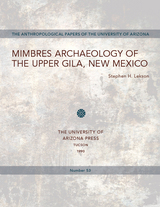
Mimbres Archaeology of the Upper Gila, New Mexico
Stephen H. Lekson
University of Arizona Press, 1990
This reappraisal of archaeology conducted at the Saige-McFarland site presents for the first time a substantial body of comparative data from a Mimbres period site in the Gila drainage. Lekson offers a new and controversial interpretation of the Mimbres sequence, reintroducing the concept of the Mangas phase first proposed by the Gila Pueblo investigations of the 1930s and demonstrating a more gradual shift from pithouse to pueblo occupance than has been suggested previously.
[more]
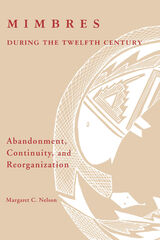
Mimbres during the Twelfth Century
Abandonment, Continuity, and Reorganization
Margaret C. Nelson
University of Arizona Press, 1999
During the mid twelfth century, villages that had been occupied by the Mimbres people in what is now southwestern New Mexico were depopulated and new settlements were formed. While most scholars view abandonment in terms of failed settlements, Margaret Nelson shows that, for the Mimbres, abandonment of individual communities did not necessarily imply abandonment of regions. By examining the economic and social reasons for change among the Mimbres, Nelson reconstructs a process of shifting residence as people spent more time in field camps and gradually transformed them into small hamlets while continuing to farm their old fields. Challenging current interpretations of abandonment of the Mimbres area through archaeological excavation and survey, she suggests that agricultural practices evolved toward the farming of multiple fields among which families moved, with small social groups traveling frequently between small pueblos rather than being aggregated in large villages. Mimbres during the Twelfth Century is the first book-length contribution on this topic for the Classic Mimbres period and also addresses current debates on the role of Casas Grandes in these changes. By rethinking abandonment, Nelson shows how movement by prehistoric cultivators maintained continuity of occupation within a region and invites us to reconsider the dynamic relationship between people and their land.
[more]
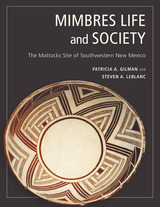
Mimbres Life and Society
The Mattocks Site of Southwestern New Mexico
Patricia A. Gilman and Steven A. LeBlanc
University of Arizona Press, 2017
A thousand years ago, village farmers in the Mimbres Valley of what is now southwestern New Mexico created stunning black-on-white pottery. Mimbres pottery has added a fascinating dimension to southwestern archaeology, but it has also led to the partial or total destruction of most Mimbres sites. The Mimbres Foundation, in one of the few modern investigations of a Mimbres pueblo, excavated the Mattocks site, containing about 180 surface rooms in addition to pit structures. Mimbres Life and Society details the Mattocks site’s architecture and artifacts, and it includes 160 figures, showing more than 400 photographs of painted vessels from the site.
Mimbres pueblos, as early examples of people using surface room blocks, are ideal for investigating questions about how and why people moved from earlier subterranean pit structures to aboveground room blocks. The authors consider the number of households living at the site before and after the transition, as well as the lack of evidence for subsistence intensification and population growth as causes of this transition. These analyses suggest that each room block on the site housed a single family as opposed to multiple families, the more common interpretation. There were not necessarily more households on the site during the Classic period than earlier.
Patricia A. Gilman and Steven A. LeBlanc spent five seasons excavating at the Mattocks site and many more analyzing and writing about Mattocks site data. They note that subtle social differences among people were at play, and they emphasize that the Mattocks site may be unique among Mimbres pueblos in many aspects. Mimbres Life and Society reveals broad-ranging implications for southwestern archaeologists and anyone interested in understanding the ancient Southwest and early village societies.
Mimbres pueblos, as early examples of people using surface room blocks, are ideal for investigating questions about how and why people moved from earlier subterranean pit structures to aboveground room blocks. The authors consider the number of households living at the site before and after the transition, as well as the lack of evidence for subsistence intensification and population growth as causes of this transition. These analyses suggest that each room block on the site housed a single family as opposed to multiple families, the more common interpretation. There were not necessarily more households on the site during the Classic period than earlier.
Patricia A. Gilman and Steven A. LeBlanc spent five seasons excavating at the Mattocks site and many more analyzing and writing about Mattocks site data. They note that subtle social differences among people were at play, and they emphasize that the Mattocks site may be unique among Mimbres pueblos in many aspects. Mimbres Life and Society reveals broad-ranging implications for southwestern archaeologists and anyone interested in understanding the ancient Southwest and early village societies.
[more]

Molly
Kevin Honold
Autumn House Press, 2021
A compelling story of characters enduring various hardships in rural New Mexico.
This debut novel tells the story of nine-year-old Raymond, nicknamed “Ray Moon” by Molly, his adoptive caretaker, a waitress, and the former partner of his recently deceased uncle. These two outcasts rely on one another for survival, and their bond forms the heart of this book. Living in a trailer atop a mesa in the high desert of New Mexico in 1968, Raymond ages quickly amid hostile circumstances. With the help of a keen imagination that Molly inspires, he navigates various forms of loss and exploitation amid enduring hardship.
Kevin Honold’s deft and trance-like prose is interspersed with sharp insights and brings attention to the displacement of Native Americans, the hardships of capitalism, the ills of misogyny, and the raw hurt of living a displaced or marginalized life. This is a story of endurance, memory, and unceasing change.
Molly was selected by Dan Chaon as the winner of the 2020 Autumn House Fiction Prize.
This debut novel tells the story of nine-year-old Raymond, nicknamed “Ray Moon” by Molly, his adoptive caretaker, a waitress, and the former partner of his recently deceased uncle. These two outcasts rely on one another for survival, and their bond forms the heart of this book. Living in a trailer atop a mesa in the high desert of New Mexico in 1968, Raymond ages quickly amid hostile circumstances. With the help of a keen imagination that Molly inspires, he navigates various forms of loss and exploitation amid enduring hardship.
Kevin Honold’s deft and trance-like prose is interspersed with sharp insights and brings attention to the displacement of Native Americans, the hardships of capitalism, the ills of misogyny, and the raw hurt of living a displaced or marginalized life. This is a story of endurance, memory, and unceasing change.
Molly was selected by Dan Chaon as the winner of the 2020 Autumn House Fiction Prize.
[more]

Murder on the White Sands
The Disappearance of Albert and Henry Fountain
Corey Recko
University of North Texas Press, 2007
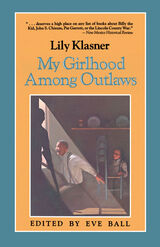
My Girlhood Among Outlaws
Lily Klasner
University of Arizona Press, 1972
Lily Klasner learned the harsh realities of frontier life at an early age. Born in Texas in 1862, she was only five when her family lost most of their provisions in an Indian raid while trekking to New Mexico; their ranch on the Pecos became a stopover for outlaws; and she assumed leadership of the family at thirteen when her father was murdered.
In My Girlhood Among Outlaws, Lily recalls her experiences with Billy the Kid and other desperadoes, and sets the record straight on popular misrepresentations of events. Of particular interest to historians is her preservation of the diary of famous cattleman and family friend John Chisum.
In My Girlhood Among Outlaws, Lily recalls her experiences with Billy the Kid and other desperadoes, and sets the record straight on popular misrepresentations of events. Of particular interest to historians is her preservation of the diary of famous cattleman and family friend John Chisum.
[more]
READERS
Browse our collection.
PUBLISHERS
See BiblioVault's publisher services.
STUDENT SERVICES
Files for college accessibility offices.
UChicago Accessibility Resources
home | accessibility | search | about | contact us
BiblioVault ® 2001 - 2024
The University of Chicago Press









